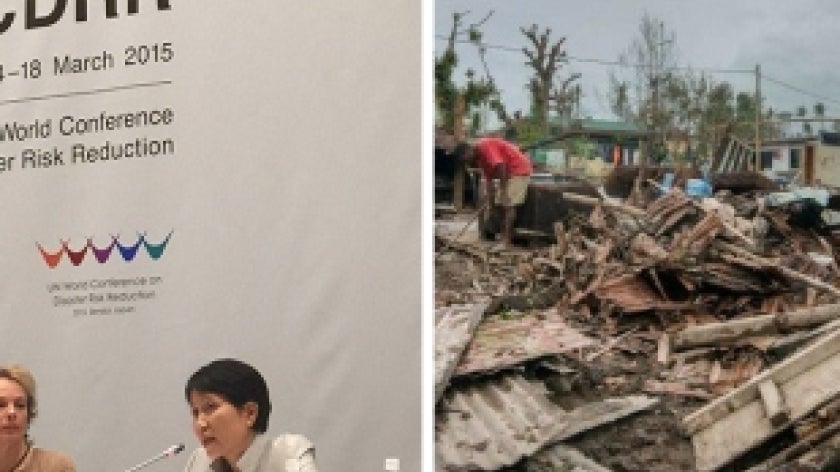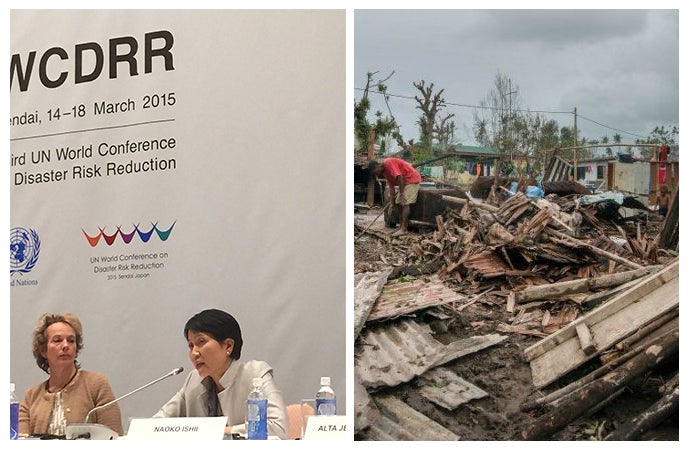

SENDAI, Japan, March 18, 2015 - The Third UN World Conference on Disaster Risk Reduction (WCDRR III) wrapped up today with an agreement on a post-2015 framework to reduce disaster risk.
The conference brought heads of states, ministers and high-level representatives of 187 countries to Sendai, Japan to agree on an international framework on disaster risk reduction for the 2015-2030 period. The framework, which succeeds the 2005 Hyogo Framework for Action, outlines seven global targets to be achieved over the next 15 years: a substantial reduction in global disaster mortality; a substantial reduction in numbers of affected people; a reduction in economic losses in relation to global GDP; substantial reduction in disaster damage to critical infrastructure and disruption of basic services, including health and education facilities; an increase in the number of countries with national and local disaster risk reduction strategies by 2020; enhanced international cooperation; and increased access to multi-hazard early warning systems and disaster risk information and assessments.
(see http://bit.ly/1Ct57x0)
GEF CEO Ms. Naoko Ishii – speaking at an event on ecosystems management and resilience – emphasized the role of environmental degradation as one of the principal, underlying drivers of disaster risk.
“Our economic activities are increasingly breaching the boundaries of key earth systems, the atmosphere, forests, land and oceans are being pushed to their limits”, she cautioned, but the GEF also sees opportunities in the interface between ecosystems and disaster risk.
“There is a huge potential for synergies between sustainable ecosystem management and disaster risk reduction”, said Ms. Ishii. “Food production and cities, for example, are hotspots of environmental degradation and disaster risk, but also areas that offer tremendous opportunities for sustainability and resilience”.
Echoing these opportunities, Mr. Pa Ousman Jarju, the Gambia’s Minister of Environment, Climate Change, Water Resources, and Parks and Wildlife, underscored the need for institutions to work together to address the interconnected challenges of climate change adaptation, disaster risk reduction and sustainable development.
In her statement at a high-level dialogue on women’s leadership, which was opened by the Japanese premier Mr. Shinzo Abe, Ms. Ishii underlined the critical role of women in safeguarding our ecosystems and reducing disaster risks.
“We know that women depend more directly on natural assets for their livelihoods and their survival. We also know that women are more adversely affected by disasters. Most importantly, however, we know that women hold tremendous potential to drive change; we see this time and again in our projects,” she said.
Relating to her first-hand experience in Sri Lanka, Ms. Ishii underlined the role that women played: “It was remarkable to witness women taking the lead in the restoration of coastal ecosystems [as part of Sri Lanka’s post-tsunami reconstruction]”.
About the Third UN World Conference on Disaster Risk Reduction and the 2015 Global Assessment Report
WCDRR III set out to complete an assessment of the implementation of the Hyogo Framework for Action; consider the experience gained through the regional and national strategies, institutions and plans for disaster risk reduction; adopt a post-2015 framework for disaster risk reduction; and identify modalities of cooperation based on commitments to implement a post-2015 framework for disaster risk reduction.
WCDRR III saw a large number of voluntary commitments from governments, international organizations and civil society to support the implementation of the outcome. Among these, Japan pledged $4 billion to support implementation of the “Sendai Cooperation Initiative for Disaster Risk Reduction”.
On March 4, the UN released the 2015 Global Assessment Report on Disaster Risk Reduction (GAR15), which found that economic losses from disasters are reaching an average of $250 billion to $300 billion annually. GAR 15 further noted that an investment of US$6 billion annually in disaster risk management could result in avoided losses of US$360 billion over the next 15 years.
Pointing to past shortcomings in addressing the underlying drivers of disaster risk, GAR 15 recommended that “managing risk, rather than managing disasters now has to become inherent to the art of development; not an add-on to development, but a set of practices embedded in its very DNA.”
Additional information
Press release: http://www.preventionweb.net/files/43290_2015no19.pdf
Sendai Declaration: http://www.wcdrr.org/uploads/Political_Declaration_WCDRR.pdf
Story provided by Knut Roland Sundstrom, GEF Climate Change Specialist